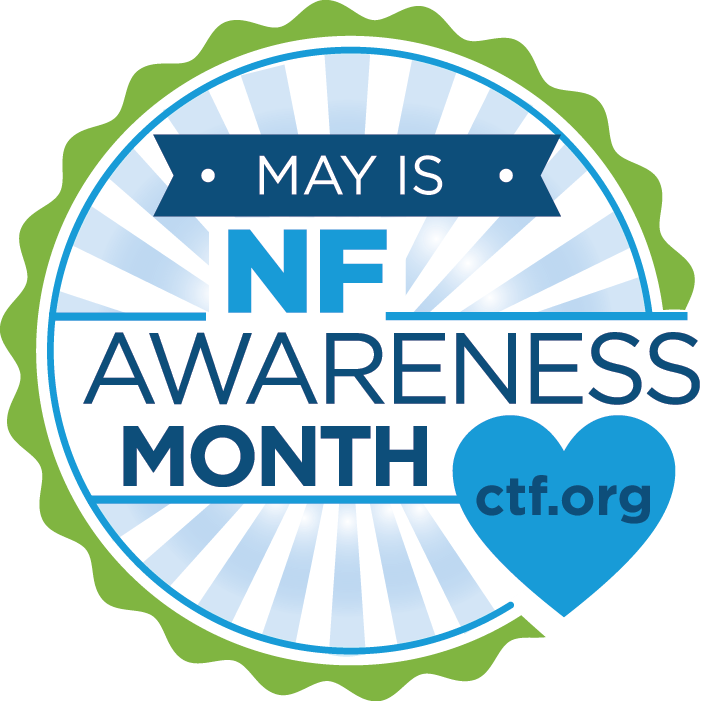Neurofibromatosis. Let’s break that down: “neuro,” is taken from the Greek word for nerves and/or the nervous system; “fibro,” meaning fiber; “oma,” meaning tumor; and “osis” meaning condition. Now put those together and you have a genetic disorder that is hard to pronounce, but even harder to explain.
Why is neurofibromatosis (NF) so hard to explain? To start, it is a genetic disorder that varies from person to person, meaning no two patients will share the exact same experience with NF. There is no way to predict how someone will be affected by NF; even within families, the symptoms varies significantly, especially in NF type 1. Adding to the confusion, half of all people diagnosed with NF have no family history. Google “NF” and you will be bombarded with pictures of men, women and children whose bodies are riddled with tumors. Sometimes you will even find pictures of “The Elephant Man,” Joseph Merrick, even though his disfigurement was not caused by NF. These are not reassuring images when you are searching for information on a disorder you or a family member has just been diagnosed with, and probably the main reason my doctor instructed me to not google the disorder.
But what is NF, how do I explain it to someone who does not speak “doctor?”
Easy, NF is the biggest nothing-to-worry about thing that a family will ever worry about. Makes perfect sense right?
NF causes a flaw, or mutation in a person’s genes. This flaw can lead to tumors that develop on nerve endings inside the body and outside, as well as a host of other issues. Tumor– it’s such a scary word. I don’t know a single person who would not be afraid of the word tumor, let alone the reality of actually developing a tumor or the possibility of developing hundreds. There are three different types of neurofibromatosis: neurofibromatosis type 1, neurofibromatosis type 2 and schwannomatosis. Type 1 is the most common form of NF. According to the Neurofibromatosis Network, NF is more common in America than cystic fibrosis, hereditary muscular dystrophy, Huntington’s disease, and Tay Sachs combined.
Still, most people have never heard of NF, even many people within the medical field. Because of this, I have become a seasoned pro at explaining the disorder and rattling off a long list of possible symptoms and issues.
NF is in a person’s genes, and our genes are inherited from our parents. They act as instructions for our design. In the case of NF 1 and NF 2, a parent with the disorder has a 50 percent chance of passing on the disorder to their child. This makes NF 1 and NF 2 autosomal dominant disorders, which means only one parent needs to carry the gene in order for it to be passed to a child.
NF 1 and NF 2 are caused by a spontaneous mutation in half of all cases, which is how I became so familiar with NF through my child’s diagnosis. Spontaneous mutation sounds like something out of an old sci-fi movie where a big green blob mutates to take over the city. I guess you could compare NF to that big scary blob; it comes out of nowhere and is extremely unpredictable, changing the lives of everyone in its path. The difference being that in the movies the big scary blob is always defeated; three types of NF exist — none have a cure. But do not think that the lack of a cure has stopped
the determination for a cure in those who are affected by NF. There is a reason people in the NF community like to use the term “fighter.” NF sucks, but those affected are some of the toughest people out there.
Scientists do not know what actually causes the gene mutation that leads to NF beyond those which are inherited, but it occurs at a
rate of about one in 3,000 births worldwide. NF can potentially cause only a few mild symptoms, or it could lead to a long list of serious problems including cognitive differences, learning disabilities, bone abnormalities, high blood pressure, varying types of tumors and café au lait spots (light brown patches on the skin).
No one can give a definitive prognosis in regards to NF, because currently there is no way of knowing how NF will affect each person. Since my son’s diagnosis in 2016, there have been many developments in research including exciting developments in understanding the gene associated with NF. Research has led to a better understanding of a few specific types of gene mutations and the symptoms associated with those mutations.
Further support for research through organizations like the Children’s Tumor Foundation (CTF) is needed to better understand NF and help find treatments for our NF Fighters. Research for NF benefits the broader medical community and has helped the
medical community to better understand some cancers, brain tumors, and learning disabilities.
May is NF Awareness Month, so take a moment to learn more about
NF and the research being done to #EndNF and improve the lives of those living with the condition. More information about NF can be found at The Children’s Tumor Foundation, NF Network,
Littlest Tumor, and NF Midwest.


